
The Elizabeth Arkham Asylum for the Criminally Insane, commonly referred to as Arkham Asylum, is a fictional psychiatric hospital/prison, appearing in American comic books published by DC Comics, commonly in stories featuring the superhero Batman. It first appeared in Batman #258, written by Dennis O'Neil with art by Irv Novick. The asylum serves as a (forensic) psychiatric hospital for the Gotham City area, housing patients who are criminally insane, as well as select prisoners with unusual medical requirements that are beyond a conventional prison's ability to accommodate. Its high-profile patients are often members of Batman's rogues gallery.
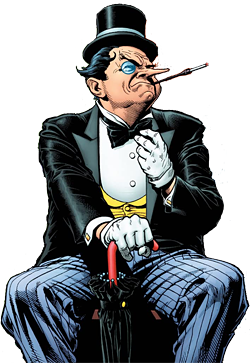
The Penguin is a supervillain appearing in American comic books published by DC Comics, commonly as an adversary of the superhero Batman. The character made his first appearance in Detective Comics #58 and was created by Bob Kane and Bill Finger. The Penguin is one of Batman's most enduring enemies and belongs to the collective of adversaries that make up Batman's rogues gallery.

The Scarecrow is a supervillain appearing in American comic books published by DC Comics. Created by writer Bill Finger and artist Bob Kane, the character debuted in World's Finest Comics #3. He has become one of the superhero Batman's most enduring enemies belonging to the collective of adversaries that make up his rogues gallery.
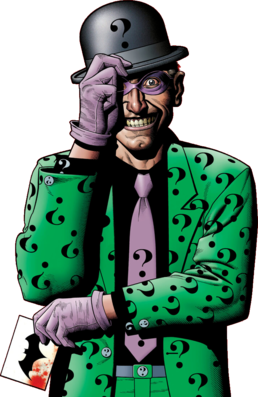
The Riddler is a supervillain appearing in American comic books published by DC Comics. The character was created by Bill Finger and Dick Sprang, and debuted in Detective Comics #140 in October 1948. He has become one of the most enduring enemies of the superhero Batman and belongs to the collective of adversaries that make up his rogues gallery.

Hugo Strange is a supervillain appearing in comic books published by DC Comics, commonly as an adversary of the superhero Batman. The character is one of Batman's first recurring villains, and was also one of the first to discover his secret identity. The character first appeared in Detective Comics #36.

The Cluemaster is a supervillain appearing in American comic books published by DC Comics, commonly as an adversary of the superhero Batman as well as a recurring enemy of Tim Drake, the third Robin. Cluemaster first appeared in Detective Comics #351 and was created by Gardner Fox and Carmine Infantino.
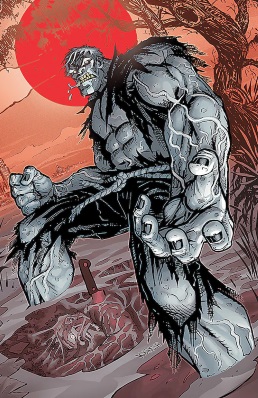
Solomon Grundy is a supervillain and occasional antihero appearing in American comic books published by DC Comics. He was originally depicted as a murder victim brought back to life as a corporeal revenant or zombie, though subsequent versions of the character have occasionally depicted a different origin. His name is taken from the 19th century nursery rhyme "Solomon Grundy". It may also be a portmanteau and pun of Solomon Gundy, a dish that is made of pickled meat and has a word origin from the French word salmigondis, which refers to a disparate assembly of things, ideas, or people forming an incoherent whole. The preserved Grundy is effectively pickled and also made of many different parts from the swamp he was buried in, resulting in the incoherent Grundy.

The Bat-Signal is a distress signal device appearing in American comic books published by DC Comics, as a means to summon the superhero, Batman. It is a specially modified searchlight with a stylized emblem of a bat affixed to the light, allowing it to project a large bat symbol onto cloudy night skies over Gotham City.

Firefly is a supervillain appearing in American comic books published by DC Comics. Created by France Herron and Dick Sprang, he made his debut in Detective Comics #184. Initially portrayed as a criminal who utilized lighting effects to commit robberies, Firefly was later reimagined as a sociopathic pyromaniac with an obsessive compulsion to start fires following Crisis on Infinite Earths' reboot of the DC Universe in the 1980s. This darker depiction of the character has since endured as one of the superhero Batman's most recurring enemies and belongs to the collective of adversaries that make up his central rogues gallery.
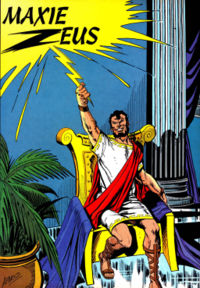
Maximilian "Maxie" Zeus is a supervillain appearing in American comic books published by DC Comics, primarily as a minor enemy of Batman. He is depicted as a mentally ill former history professor who is obsessed with Greek mythology and believes himself to be the god Zeus, becoming a crime lord in Gotham City.
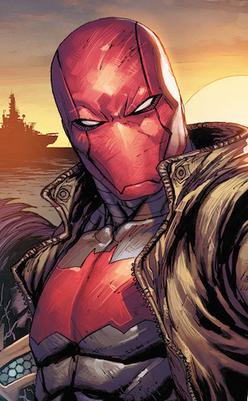
The Red Hood is an alias used by multiple characters appearing in American comic books published by DC Comics. The identity was first used in the 1951 story line "The Man Behind the Red Hood!", which provides the earliest origin story for the Joker. The storyline depicts an unnamed criminal wearing a red dome-shaped hood who, after a chance encounter with Batman, is disfigured by chemicals and becomes insane, giving birth to his future Joker persona.
The Tally Man is the name of two fictional supervillains in the DC Universe.
Originally created in 1967, the fictional comic book character Barbara Gordon has been adapted into various other forms of media. The character has appeared in both live action and animated television series and films, as well as in video games in her alter-egos as both Batgirl and Oracle.

Tweedledum and Tweedledee are a duo of supervillains appearing in comic books published by DC Comics, primarily as enemies of Batman.

The Riddler, a supervillain in DC Comics and an adversary of the superhero Batman, has been adapted into numerous forms of media, including feature films, television series, and video games. The character has been portrayed in live-action by Frank Gorshin and John Astin in the 1960s television series Batman, Jim Carrey in the 1995 film Batman Forever, Cory Michael Smith in the 2014 Fox series Gotham, and Paul Dano in the 2022 film The Batman. Actors who have voiced the Riddler include John Glover in the DC Animated Universe, Robert Englund in The Batman, and Wally Wingert in the Batman: Arkham video games.

Duke Thomas is a fictional character appearing in comics published by DC Comics. He was created by Scott Snyder and Greg Capullo. He was introduced as a supporting character of Batman, his first appearance being in 2013 in Batman #21, before later leading a youth vigilante movement inspired by Robin, in the comic book We Are... Robin, in May 2015. He officially became Batman's newest partner and joined the Batman family in 2016.

The character Two-Face was created by Bob Kane and first appeared in Detective Comics #66. However, he did not appear outside comics until half a century later in Batman: The Animated Series. Two-Face has since been substantially adapted from the comics into various forms of media, such as feature films, television series and video games. Two-Face has been voiced by Richard Moll in the DC Animated Universe, Troy Baker in the Batman: Arkham series, Billy Dee Williams in The Lego Batman Movie, and William Shatner in Batman vs. Two-Face. His live-action portrayals include Billy Dee Williams in Batman (1989), Tommy Lee Jones in Batman Forever, Aaron Eckhart in The Dark Knight, and Nicholas D'Agosto in the television series Gotham. In 2009, Two-Face was ranked #12 on IGN's list of the Top 100 Comic Book Villains of All Time.

Batman: The Long Halloween is a 2021 American two-part animated direct-to-video superhero film produced by Warner Bros. Animation and DC Entertainment, based on the DC Comics storyline of the same name. Part 1 is the 44th film, and Part 2 is the 45th film, of the DC Universe Animated Original Movies, with both parts serving as the third and fourth installments of the Tomorrowverse. The film is directed by Chris Palmer and stars the voices of Jensen Ackles, Josh Duhamel and Naya Rivera in her final film role. The film is dedicated to Rivera following her death the year prior. In both parts of the film, Batman attempts to unravel the mystery of murders committed on holidays throughout the year, and uncover the true identity of the serial killer Holiday.
















